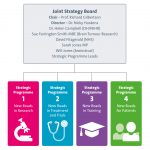Dr Tanya Malpass was an A&E Consultant who in February 2015 found herself becoming a brain tumour patient, and in late 2018 she became a published author. ‘The Hope That I Have – to remission and beyond’ details the incredible journey that Tanya has been on.
Dr Tanya Malpass
After graduating from Manchester Medical School, Tanya trained at Guys Hospital London and became a consultant in Emergency Medicine. She worked for over 20 years, resuscitating patients with multiple injuries, setting bones, treating heart attacks, stitching up victims of pub brawls and removing lego blocks from the noses of small children. After managing a busy department and bringing up three children, she took early retirement from the NHS, though continued to act as a professional clinical adviser to the Parliamentary and Health Service Ombudsman. She fitted this in around home educating her youngest son, who has Asperger’s syndrome, a task she found even more challenging and enjoyable than emergency medicine.
A life-changing diagnosis
In February 2015, everything in Tanya’s life changed, when she was diagnosed with a grade 4 glioblastoma multiforme (GBM), with an estimated average prognosis of around 12-18 months. This challenged her own understanding of medicine, treatment, prognosis, health, disease and lifestyle.
Tanya’s response to her diagnosis was to take a holistic approach to what she was facing. So while she got to grips with researching the medical treatments that she was to face (surgery, radiotherapy and chemotherapy), she also embarked on exploring the more holistic factors of diet, lifestyle and attitude, with her focus on positivity and hope. Tanya says: “Hope is the single most important therapeutic measure that can be deployed in the treatment of any disease. You can be prescribed the best medicines, you can undergo the most skilled surgery, you can take all measure of supplements, chemicals, chemotherapy, diets, radiotherapy or any other remedy, but if the patient (and in some cases the doctor) has no faith in their working, they most certainly will not.”
Three years on…

Today, three years on, Tanya is living a full life, with no sign of recurrence, joyfully exceeding all statistics, and with every intent to do so for many years to come. The experience has left her with a deep desire to pass on what she has learned and, with it, the Hope that she has. Tanya has now published her book all about her brain tumour journey, and it’s inspirational reading. She writes all about the power of Hope that she has harnessed, together with the changes she has made to her lifestyle, diet, and way of thinking. Interweaved with the telling of her fascinating personal story, Tanya offers the reader an evidence-based insight into her approach to diet, exercise and mindset.
A longstanding friend to brainstrust, Tanya will be running a workshop for us soon all about her journey and to share with us her positive approach to medicine, treatment, prognosis, health, disease and lifestyle.
The book can be purchased on kindle format here, or paper copies can be purchased here. You will also be able to purchase paper copies at our forthcoming workshop with Tanya, and at our London meetups.
Tanya’s website is: www.bobtheblobsblog.com





